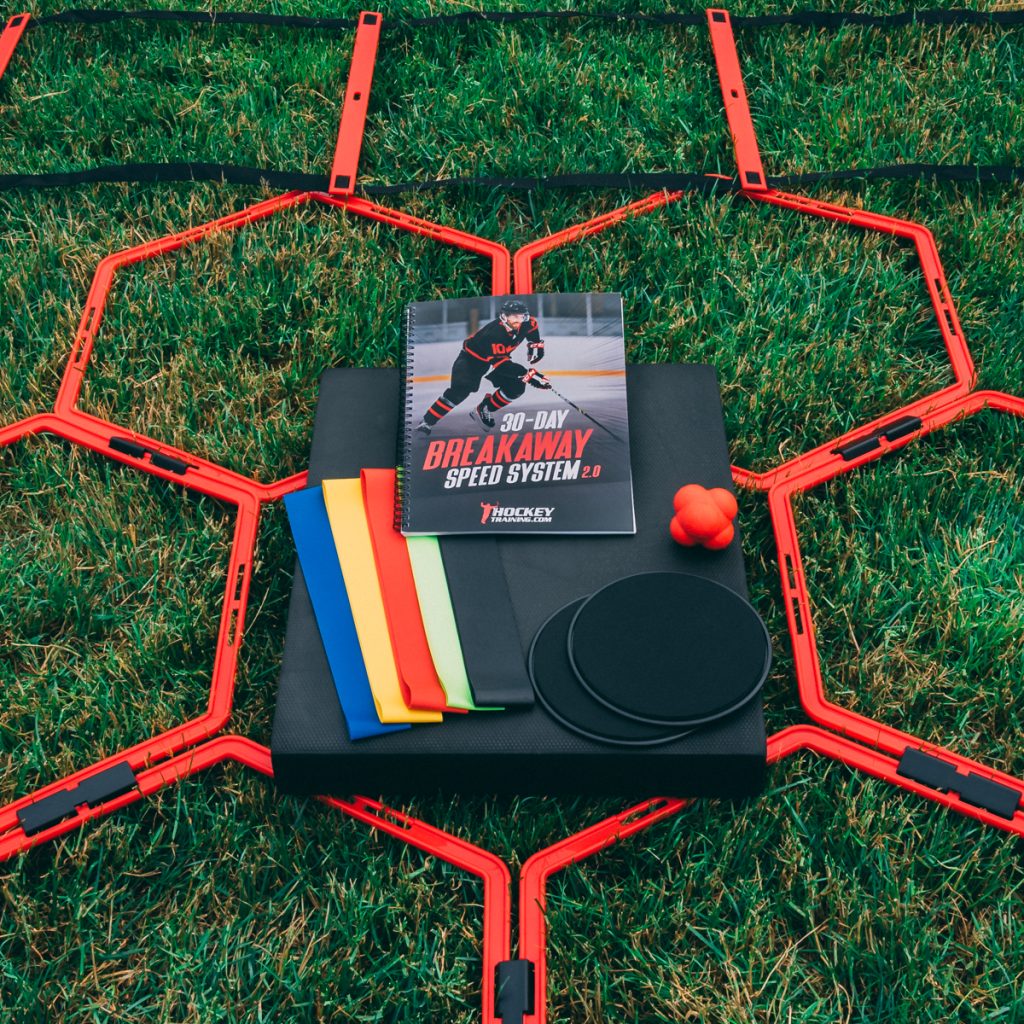In today’s article, I’m going to teach you the best plyometric exercises that hockey players can use to improve their explosive speed, acceleration, and overall conditioning.
And I will help you avoid the abuse of plyometrics that will actually negatively affect your hockey performance.
Your Roadmap to Smarter Plyometric Training
Real Plyometric Training for Hockey
I’m speaking to all of you out there – athletes, coaches, and parents…
Plyometric drills are one of the most abused training techniques currently being used by strength and conditioning coaches.
Of course, when used wisely, it’s a SUPER effective training method.
In fact, you will find plenty of properly sequenced plyometric workouts within the training programs I have designed here at Hockey Training.
When used properly, they can increase speed, functional power output, and conditioning levels out on the ice.
This is very well documented within the literature at this point in time.
When done properly, you can receive three major benefits:
#1: Agility
Plyometric drills are incredibly efficient at improving the time it takes for you to switch from an eccentric (muscle lengthening) contraction to a concentric (muscle shortening) contraction.
This “in-between” phase is known as the amortization phase, and it is at the pinnacle importance for improving agility.
The stop-start speed that is so desirable in hockey for elite levels of agility is very much represented by how fast (or in contrast, how slow) you can effectively switch from an eccentric contraction to a concentric contraction.
An example of when this comes into play on the ice is when a hockey player is backchecking and turnover is forced. The player needs to stop as quickly as possible and explode in the other direction up the ice to create a scoring opportunity on offense.
The faster you can stop and start on the ice, the better off you will be in a variety of game situations.
#2: Neural Changes
We have seen in strength and conditioning science that athletes who partake in plyometric training can recruit more muscle fibers and motor units during movements, which allows them to initiate movements faster and with more force.
For example, let’s say you have two hockey athletes, and they are both of equal ability.
But, one of them decides to do plyometric training for a proper 8-Week phase, whereas the other chooses not to.
By the end of the phase, the athletes who decided to do proper plyometric training will be measurably faster and more explosive than his/her non-plyometric training counterpart.
Furthermore, the athlete who decided to do plyometric training will not only be faster and more explosive – but from a neural perspective, he/she will also improve their explosive efficiency.
Meaning, even though the player is moving faster/more explosive – he/she will not be creating more fatigue along with it.
#3: Structural Progression
Plyometric exercises cause some post-workout muscle soreness due to the level of muscle damage they cause during training.
This is very understandable given the amount of force you produce each workout doing these movements.
But what’s important to note here is that they do not cause significant muscle hypertrophy.
Meaning, they aren’t as useful for muscle growth in comparison to a more standardized weight lifting approach.
I mention this because although structural adaptations occur in response to plyometric training, they aren’t the changes most hockey players would come to expect.
Plyometrics aren’t about adding more muscle quantity.
Instead, they are about improving muscle quality by boosting the strength capacity of each muscle fiber.
Should Hockey Players Always Do Plyometric Training?
The hockey performance benefits, combined with the fact that plyometrics create rapid results for athletes, has coaches salivating.
But, unfortunately, this leads to coaches overusing them in their programming year-round.
Roman’s research all the way back in 1986 showed us that the results from plyometric training severely taper-off after only one month.
So, the coaches out there forcing their athletes to perform plyometrics year-round aren’t getting better results than the coaches who are creating proper periodized strength and conditioning systems that include plyometric blocks of training 3-5x per year for 4-week phases.
In other words, these coaches are abusing these techniques rather than using them to maximize their benefits alongside a “big picture” well-designed program.
Another reason why they are totally overdone in hockey training is that athletes don’t feel as tired after doing them.
Meaning, 3 sets of 10 depth jumps seems much more approachable to most athletes than 3 sets of 10 deep barbell back squats.
Athletes and coaches typically evaluate the effectiveness of a workout based on the fatigue they are receiving.
And since there isn’t as much “tiredness” associated with the plyometric work, they think they need to “do more” to get a training effect.
Not only is this counterproductive due to learning poor movement patterns in a fatigued state, but it can also dramatically increase the risk of injuries in hockey athletes.
And if you know anything about competitive hockey, these athletes don’t need any more injury risk than there already is!
Plyometric Program Design for Hockey Players
If you want to do plyometric training correctly for hockey so that you can reap all of the fantastic benefits but minimize all of the associated costs, follow these crucial instructions:
- The joint positions you use to explode during movement should be as close as possible to the sport movement you are trying to mimic
- The amortization phase should be short enough to avoid losing any elastic energy you create, but long enough to allow for a stretch to occur.
The research suggests that elastic energy can last for up to two seconds when performing plyometric movements.
So, theoretically, you have a two-second window between the landing-phase and the take-off phase to maximize your results.
Having said that, I recommend you try your best to keep this less than one second
- The difficulty of the movement needs to match the preparedness of the athlete. In other words, do not do movements just because they look cool. Plyometrics can be dangerous and thus should be highly individual in their exercise selection
- Plyometrics have a powerful effect on the body, so the training volume should be very low. Staying within the range of 4-8 sets of 3-5 jumps is more than enough even for the most advanced hockey athletes in the world
- Because of the training effects, residual fatigue, and injury risk – it is not recommended to do plyometric training year-round. 3-4 dedicated training blocks per year is more than enough to suffice here (especially since there are so many other ways you can train speed and explosiveness as well)
Best Plyometric Exercises for Hockey Players
Now that you can place context and periodization into your programming, here are some of my favorite plyometric exercises that I have seen get the best results for improving on-ice performance across my years as a hockey performance coach:
Plyo Push Up Onto Elevation
Box Jumps
Single-Leg Box Jumps
Broad Jumps
Single-Leg Broad Jumps
Skater Bounds
Tuck Jumps
Pike Jumps
Depth Box Jumps
Split Squat Jumps
The Solution
Pictured above is our brand new Breakaway Speed Kit that we just launched to help hockey players of all ages who want to improve their explosive skating speed!
The kit includes the six hockey speed tools that I consider “must-haves” if you are serious about doing the best possible plyometric work to improve your hockey performance.
Additionally, it comes with our brand new 30-Day Breakaway Speed System so you can put to use all the knowledge you learned above into a “done for you” advanced dryland hockey training program…
The all-new 30-Day Breakaway Speed System was designed to take all of the guesswork out of it for you so you can train with the most cutting-edge methods to get serious results.
This is an intense 30-day progressive SAQ training approach that includes weekly workouts focused on speed, agility, endurance, and conditioning to help you become an elite skater…
You will gain access to a comprehensive 30-day schedule that outlines exactly what to do each day…
And you will be performing each of your high-level workouts with your new Edge Work Enhancer Ladder, Explosive Speed Rings, Hockey Reaction Ball, Balance Foam Pad, Skater Sliders, and Athletic Movement Bands…
So you can train just like the top NHL players (no matter your age)!
Remember, if your hockey speed isn’t where you want it to be, it’s not your fault…
Real speed progress comes from real hockey-specific training, and this type of programming can only be provided by a hockey performance specialist.
That’s why each workout has been formulated with Beginner, Intermediate, or Advanced training options.
So that no matter where you are currently at in your hockey training journey you will be able to see dramatic results after only 30-Days of using the Breakaway Speed System and the advanced training tools found in your Hockey Speed Kit.
The best part?
This new 30-Day Breakaway Speed System can be used as a standalone program or be added to the existing program you’re currently running so that you can get better results no matter what your current training schedule looks like…
Your days of guessing and hoping to become a better hockey player are over…
Get started with the 30-Day Breakaway Speed System today so you can leave fans, coaches, and scouts jaws on the floor with how much progress you have made in a single month of training. Click here to get the Breakaway Speed Kit today!
Final Thoughts
It’s essential to remember that every training method you use, no matter how effective it may sound, will always have an expiration date in terms of its applied effectiveness within a continuous training block.
Plyometrics are no different. If you use them year-round, there will come a time when you lose the cost-benefit analysis.
However, using short blocks of it within your yearly periodization can be a very, very wise thing to do.
In the end, it’s just like anything else.
Use it, don’t abuse it.



Nice stuff. I usually throw one or more of these plyo exercises into all my workouts. Definitely kicks things up a notch!
What is the duration of Plyometrics workouts before you stop and change your workouts -6wks or 8wks or 12 wks ( how many plyometric execs should one have in a workout)
What type or workout should one change to from plyometrics
thanks
Hey there,
Going to answer your questions in the order they were presented:
1. Typically you would incorporate plyometric training for 8-12 weeks or so (ideally within the last 3-4 phases of your off-season programming).
2. I like to use around 2-3 plyometric exercises per workout and vary the movement pattern (e.g. vertical, horizontal, and lateral).
3. After you are finished your plyometric work, you would most likely be going into the in-season which is where you would back off from super high-intensity programming. This is the type of training you would go into afterwards.